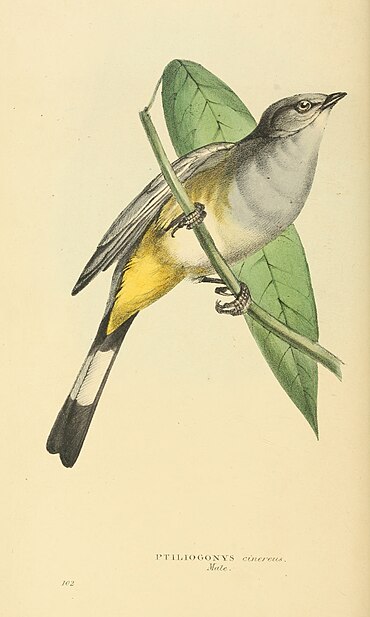PTILIOGONYS cinereus.
Male.
On the sixty-second plate of these Illustrations, we figured the female of this elegant and highly interesting bird, from a specimen sent to us from Mexico, by the late Mr. W. Bullock. We are now enabled to add the male from a fine example, obligingly presented to us by John Taylor Esq. F. R. S. It was killed near Real del Monte; and these, we believe, are at present the only specimens that have reached England.
PTILIOGONYS cinereus, male.
Yellow-vented Short-foot.
Family Laniadæ. Sub-fam. Tyranninæ. Genus Ptiliogonys. Nob.
Generic Character.
Zool. Journ. no. 10. p. 164.
Specific Character.
Light cinereous; flanks olive; under tail covers bright yellow; quills and tail glossy blue-black, the latter ornamented with a central snowy band; chin and vent white.
For Synonyms—see pl. 62.
By viewing this as the type of the Scansorial group of the Tyrant-flycatchers, (Tyranninæ) every circumstance, even the most minute, regarding its structure and its colours will be explained. As representing Brachypus, (North. Zool. 2. 485.) and its analogies, it has the under tail covers richly coloured. As representing Leiothryx (Il. 490.) it has the same coloured cinereous and silky plumage: as a scansorial type, it has a conspicuous although an incumbent crest, and a long ornamented tail. It is a Titmouse among the Tyrants, and is nearly as much of a Ceblepyris as of a Tyrannus. Indeed, when we described the female, we thought it actually entered the circle of the former, but the laws of representation has set us right on this point. Phœnicornis is the first of the Ceblepyrinæ, as Philiogonys is the last of the Tyranninæ. The females of Phœnicornis are clothed in the same slate coloured plumage, but, as being of a fissirostral type, their mouths are conspicuously bristled, while those of Ptiliogonys are quite smooth. Finally, the wings are those of a Ceblepyris, but the tail that of a Tyrannula!
